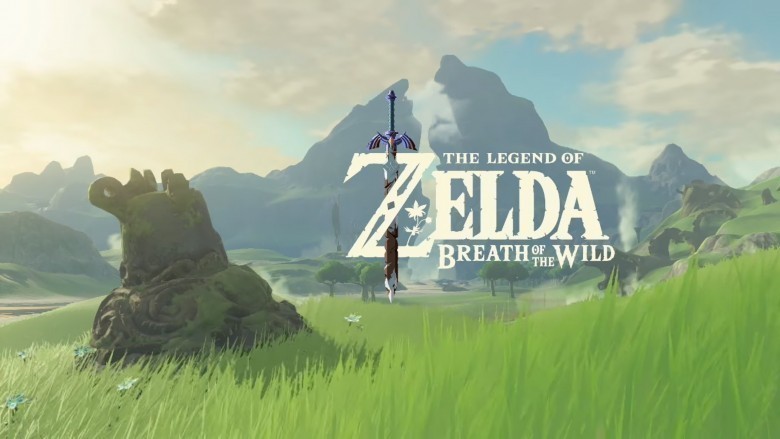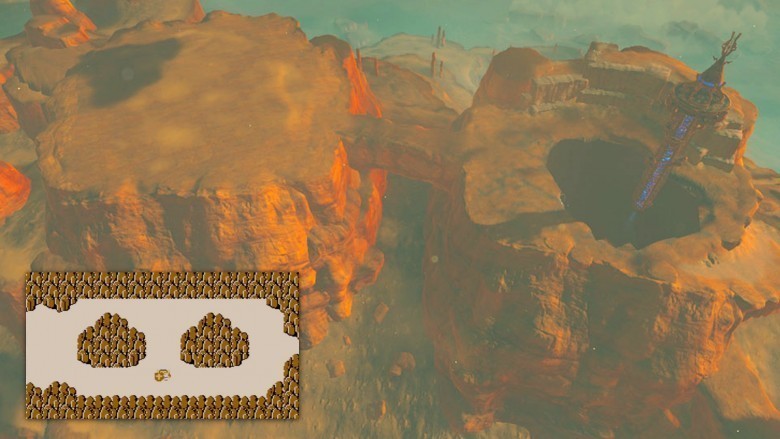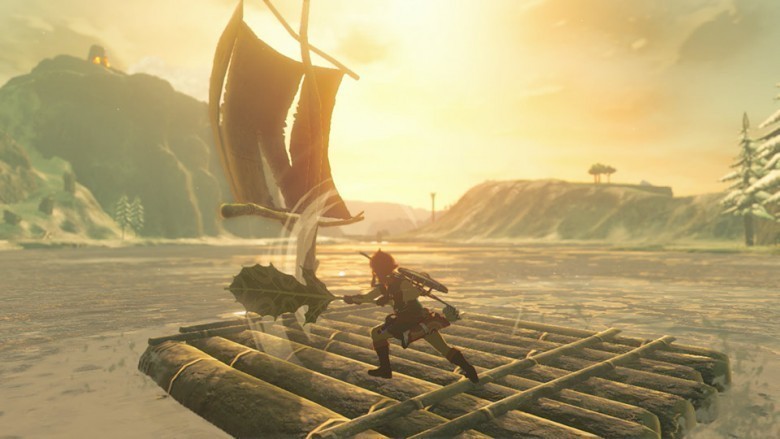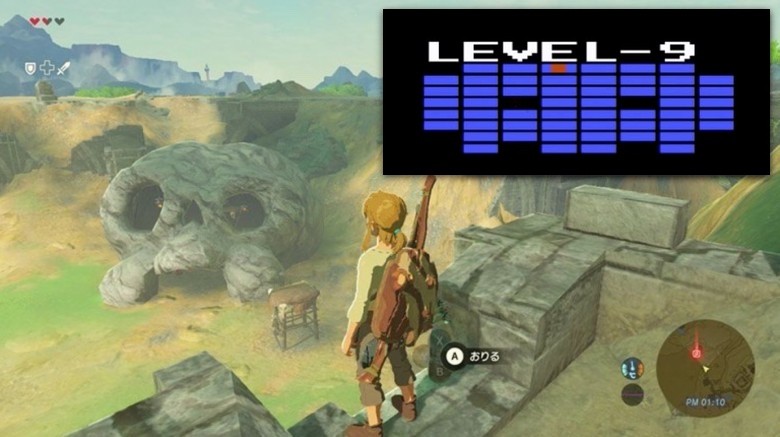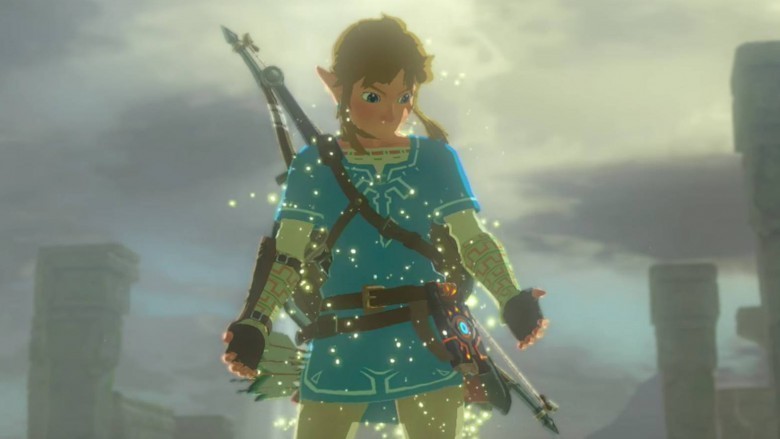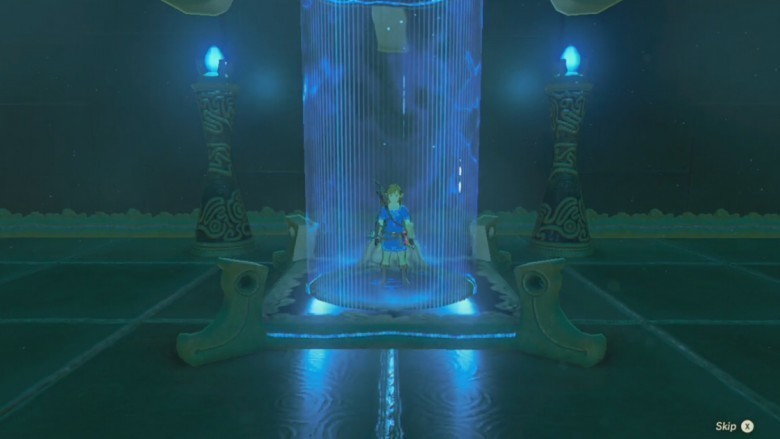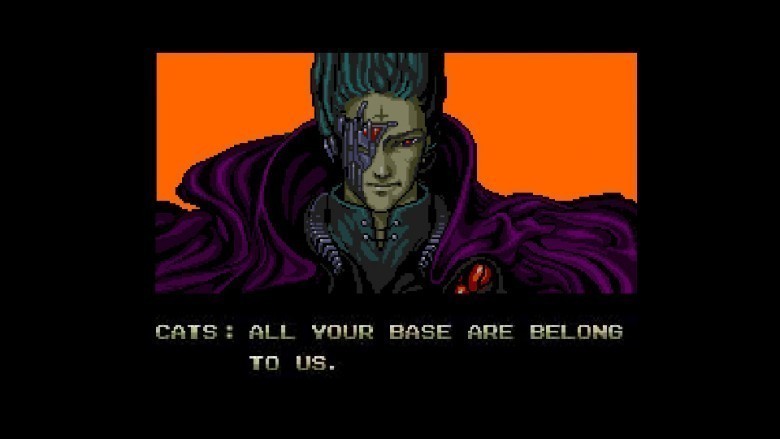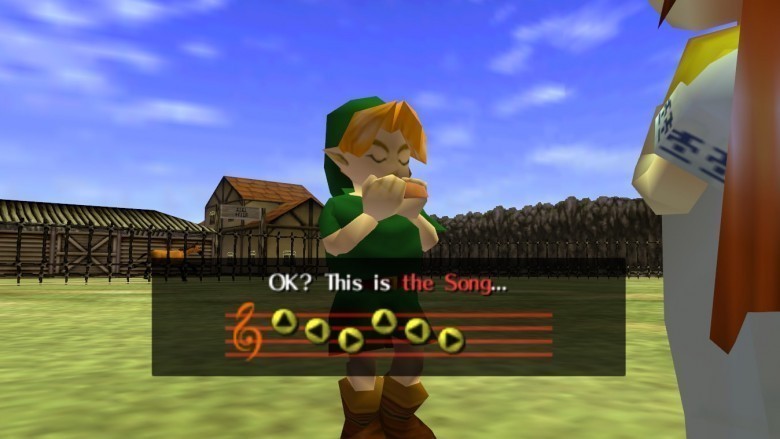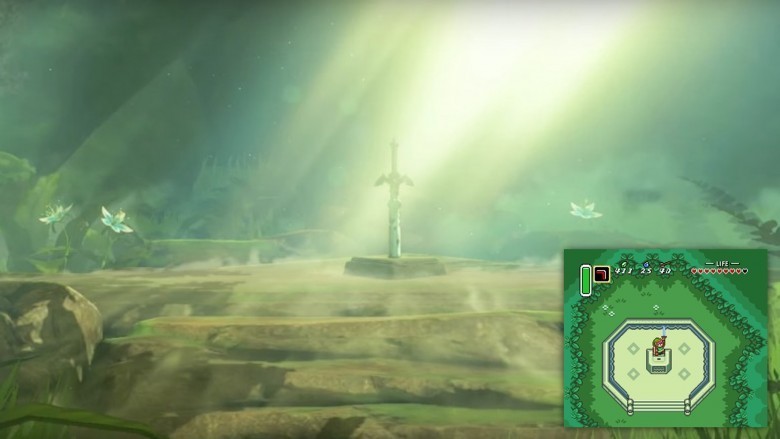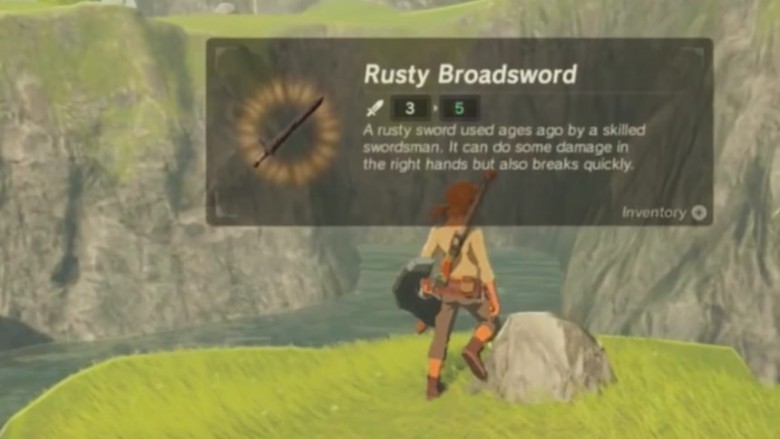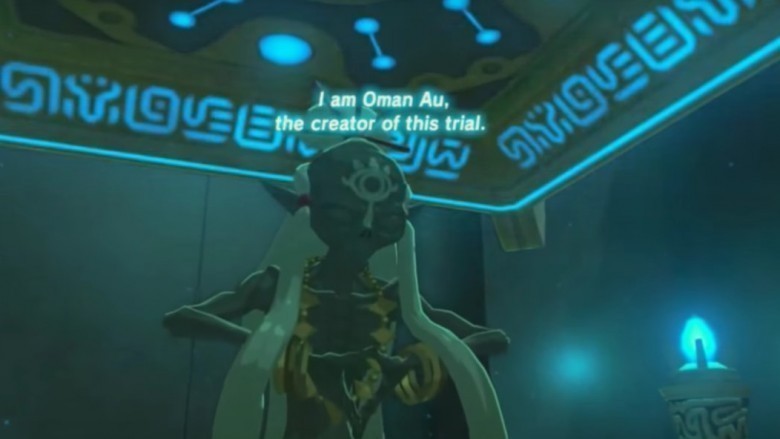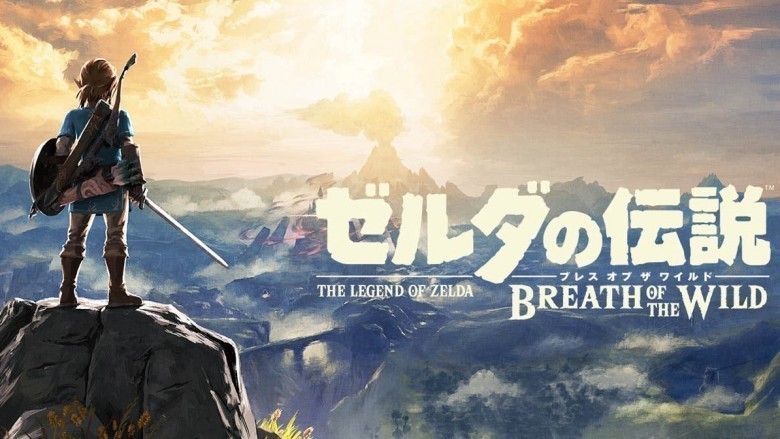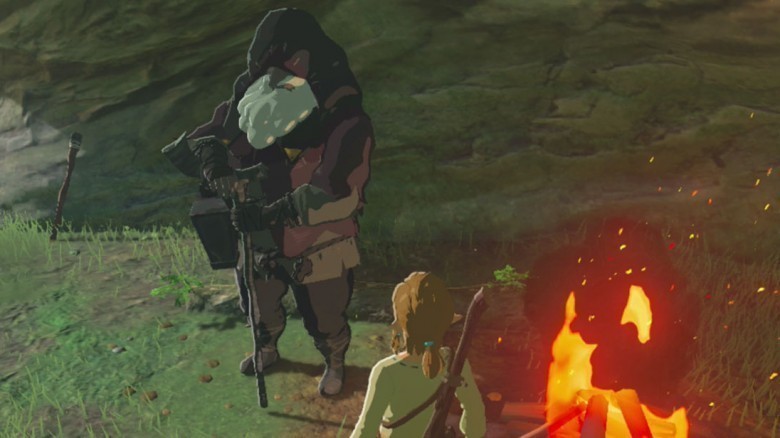Small Details In Breath Of The Wild Only True Fans Noticed
As the impressive 19th installment in the The Legend of Zelda series, Breath of the Wild brought in advance buzz by the bushelful, and when fans finally snagged it for themselves upon the launch of the Nintendo Switch, they noted its balance between originality and honoring the overall Zelda narrative. But what players likely haven't yet noticed, however, are the exciting Easter eggs sprinkled throughout the game. Here's a look (with some potential spoilers included) into the Breath of the Wild Easter eggs you missed while taking the title for a spin.
New Spectacle Rock
Since its first release over 30 years ago, The Legend of Zelda series has featured a ton of lush landscapes in which Link gets his adventure on, and amongst those grassy knolls and spooky saves are a few particular structures that stand out. Easily one of the most recognizable is Spectacle Rock from the original 1986 Zelda, which has cropped up in later installments as well. Breath of the Wild features a near exact recreation of the glasses-shaped pair of rocks, which can be seen in wide-angled shots from above. And this time, the famous formation appears on a much larger scale; rather than navigable, grounded rocks sitting two-by-two, Breath of the Wild's Spectacle Rock is seen in the enormous, twin-peaked mountains. An homage to its predecessors so subtle yet with a new spin, it's understandable why it slips under the radar.
Return of river rafting
Here's yet another clever nod to the game that started it all. Riding the river currents on a small raft is something many OG Zelda fans may remember, particularly as the winding road to the finish line becomes clearer. In Breath of the Wild, Link hops aboard—you guessed it—a raft to continue on his princess-saving endeavors. This time around, our green-capped hero gets quite the upgrade for his aquatic travels, as his river raft is much larger than the original. Onward and upward, little Link!
The super-sized skull
Another noticeable structure that shows up in Breath of the Wild is again borrowed from the granddaddy of all Legend of Zelda games. Skulls are a recurring item in the series, seen in tiny two-toned totems and mystical mementos, and the franchise's first game featured a final dungeon which, seen from the inside, is mapped out in the shape of an ominous skull. Breath of the Wild brings back the good ol' bones-for-brains landmark, just placing it on a different spot in the game's map. Here, enemies take cover in the opaque skull, but Link can manage to light a (literal) fire under the bad guys' butts to send them packing.
Location, location, location
As with its more minute references to map formations, Breath of the Wild calls back to those that came before it in a slew of place names. These revamped titles are inspired by other locations and a handful of eccentric players, often changed by switching up letters or phonetic spellings, making them almost too easy to slip right by players.
Breath of the Wild's Tingel Island is a misspelling of the flamboyant finesser Tingle, who appears time and again throughout the series. Toronbo Beach and Koholit Rock in BoTW are namesakes of Toronbo Shores and Koholint Island, both of which appeared in The Legend of Zelda: Link's Awakening almost 14 years ago. Mido Swamp grabs its title from the Kokiri Forest-dwelling character Mido seen in Ocarina of Time. There are more Breath of the Wild locations that snag their names from an even earlier source, referencing towns in Zelda II: The Adventure of Link: Rauru Hillside, Ruto Lake, and even Saria gets a nod. All of these towns were later revealed to be named after people in Hyrule in Ocarina of Time, so their legacy winds throughout the series.
The Minshi Woods get their name from the Hyrulean race of people known as the Minish, the diminutive creatures featured in the 2005 title The Legend of Zelda: The Minish Cap. Linebeck Island takes from the stumbly and hesitant assistant of the same name who sat by Link's side in Phantom Hourglass. But perhaps the most chills-inducing Easter egg is that the Temple of Time from Ocarina of Time also appears in Breath of the Wild, under the same name with a similar structure. Additionally, the Ranch Ruins in the latest installment are incredibly reminiscent of the Lon Lon Ranch also seen in Ocarina, as both feature similarly-placed vases, a squared-off archway entrance, and a chimney-like brick structure sitting in almost the same spot on both maps.
These references are as sneaky as they are smart, and the everyday Zelda fan could have easily missed them.
The gem hidden in the fantasy language
An element of Breath of the Wild that has left players both starry-eyed and scratching their heads is the mysterious Sheikah language used in various items, signs, and descriptions throughout the game. However, one Reddit user, sparkthedarkness, presented Breath of the Wild users with full translations of the Sheikah symbols, which spans across numbers, letters, and random symbols. Many have utilized this translation key to decipher hidden messages—few more interesting than one winding bit of text that appears on the special edition boxed version of Breath of the Wild and reads, "The Hyrule Fantasy," which is the subtitle of the original The Legend of Zelda's Japanese release—leading fans to speculate how the two titles might connect.
Nintendo's self-aware joke
The Sheikah language in Breath of the Wild doesn't just stir curiosity about what the newest installment could mean, it also allows Nintendo to poke fun at themselves.
If you were around in the late '80s, you've likely played first-hand the side-scrolling shoot 'em up arcade title Zero Wing, and if you weren't, you've probably heard of one particular internet meme that made Zero Wing infamous in the gaming community. When installing new abilities to Link's Sheikah Slate in Breath of the Wild, text scrolls down the screen. Some phrases can be translated as "now loading" and "do not turn off your [slate]," but a hilarious Easter egg can be found in the sentence that reads "All your base are."
This, of course, is a reference to the English version of Zero Wing, which abysmally translated the game's original Japanese into the jumbled-up phrase, "All your base are belong to us." The dialogue was so butchered, gamers couldn't help but share it with others, and with this Easter egg, Nintendo makes light of a now-legendary past mistake.
A song as old as rhyme
Gameplay, narrative, and aesthetic design aside, The Legend of Zelda has also been applauded for its now-iconic whimsical soundtrack, with songs that perk listeners up with just a single note. Because of this, it's been rather common to see (or hear, rather) Easter eggs snuggled up in series additions' songs. Take The Legend of Zelda: Skyward Sword, for instance, whose "Ballad of the Goddess" is simply "Zelda's Lullaby" played in reverse.
It appears Breath of the Wild continues this trend in its "Hyrule Fields" theme. When listening to the tune while you roam the open fields, pay close attention to the background violin, whose faint and disconnected melodies can be strung together to make a version of none other than "Zelda's Lullaby." Albeit difficult to spot at first when played at normal speed, players can more easily hear the similarities when the audio is sped up, a discovery made by YouTube user tmo. Well-hidden and winsome, this Easter egg is something quite special.
A (literal) link to the past
When viewing the Master Sword in Breath of the Wild, shown sealed up in its pedestal in the game's official E3 trailer, players have insisted that it's not the blade itself you should be focusing on, it's the flowers. Upon closer inspection, the beautiful foliage in the background of a particular shot of the Master Sword perfectly aligns with the placement of the flowers in The Legend of Zelda: A Link to the Past. Considering this clear-cut nod to the franchise's history, many longtime Zelda fans have started concocting their own theories about what this Easter egg could mean.
Master of no one
In Breath of the Wild, gamers can grab what appears to be the Master Sword fairly early on in the game, where it sits perched on a tall rock formation. Disappointingly, though, it ends up being a run-of-the-mill, rusty Broadsword instead. And here's where the Easter egg sits. In A Link to the Past, Link traverses the Lost Woods and believes he's stumbled upon the actual Master Sword. The Woods are filled with glittering pedestals and, obviously, tons of dummy swords, but Link is led to think he's found the for-real blade when he pulls it up from the ground. Upon the satisfying schwing!, he's prompted with this message: "This is it! The Master Sword!" Then it all falls to pieces when it's revealed it's a total dupe. Poor Link, always getting deceived.
Oman Au = Aonuma
The monks of Breath of the Wild have some unique names, but one sticks out: Oman Au. Rearrange the letters of the monk's name and you get Aonuma. This is a direct connection to Eiji Aonuma, the renowned video game designer, director, and producer at Nintendo and current series producer and manager of The Legend of Zelda series. As evidenced in the game's other Easter eggs, names are super important in the franchise, and Oman Au's is no different.
New old Japanese logo
For as long as most fans can remember, the Zelda logo has remained the same with each new game and has been consistent in global releases. But with Breath of the Wild, things have been shaken up quite a bit. While overall, the logo for BoTW follows the standard format seen in past installments, the Japanese version takes us back a couple of decades to mirror the "Hyrule Fantasy" logo, one that hasn't been used in 20 years. Again, this Easter egg has sparked conversation on whether there's a deeper meaning, or if it's merely down to a design choice. We'll have to wait and see.
The Old Man and the dangers of exploration
One thing that isn't new is the Old Man, clearly a reference to the same old dude seen in the original Zelda game who gives Link his first sword and gives him some ominous advice. Upon entering the cave to meet the man, Link is warned that "it's dangerous to go alone."
This cryptic character shows up again in Breath of the Wild, again with a fire, and again in a small cave. Of course, it could be a simple coincidence. Weird old men love caves, after all. But then, Nintendo stacked another juicy Easter egg in there. The Sheikah letters pouring out of light-beacons you can place contain a hidden message that links players all the way back to the original Zelda. The secret words? "It's dangerous to go alone."

